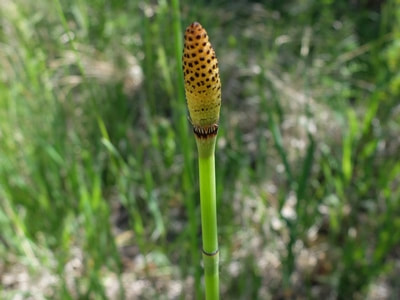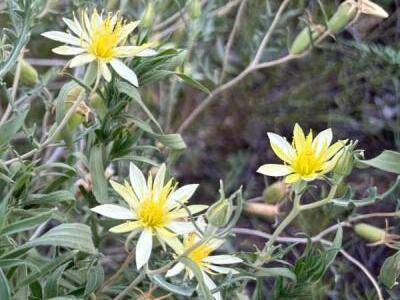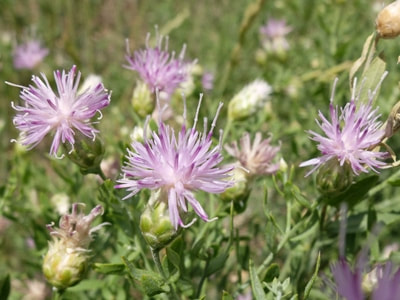Smooth Scouring Rush, Smooth Horsetail,Equisetum laevigatum,Horsetail Family (Equisetaceae)7/26/2024 Found in moist, open areas, river banks
Seen in July by the Rio Chama Scouring Rushes are not Rushes; they are Horsetails, which are prehistoric organisms that thrived 400 million years ago during the Paleozoic era. They grow from one to four feet tall with a ridged, hollow, bamboo-like stem. The leaves are reduced to tiny, dark teeth fused into a sheath around the joints of the stem; teeth are usually shed during the growing season. It produces spores, rather than seeds, from flowers in pine cone-like heads. Native Americans had many uses for the plant. The stems were used to do the final polishing of wooden spoons and to polish the soft rock used for pipe bowls, to give medicine to babies and used by children as whistles. It was given to thin, old horses with diarrhea after eating fresh grass in spring. It was used medicinally as a contraceptive; to stimulate the kidneys; to treat bladder ailments, hemorrhoids, high blood pressure, venereal diseases, backaches, and colds; also used as an insecticide for washing hair and to treat parts of the body affected by poison ivy. Source. If you are trying to identify a different flower then you can check what other flowers bloom this month. If you cannot identify a flower from the website, send a photo and where you took it to [email protected]. Read online for tips.
2 Comments
The Bloom Blog Blooming this week in the environs of Abiquiú By Wildflowers of the Southern Rocky Mountains Found at roadsides and in dry, sandy areas Seen blooming in July near Hwy 554 Blazingstars are also called Eveningstars because they do not open until late in the afternoon, this photo was taken at 7.30 pm. During the day their flowers are tightly closed so easily overlooked. They are in the Stickleaf family, so named because their leaves have barbed hairs and stick to clothing and fur like Velcro. It grows to 2 ½ feet tall with stout white branched stems. Flowers are 2" across with long yellow stamens. Flowers can be bright yellow, but I mostly see pale yellow, almost white flowers in this area. Traditionally, the seeds have been eaten raw or ground into a meal. Medicinally it has been used to treat tuberculosis, as a diuretic, a laxative and as a pain reliever for rheumatism and toothaches. Tewa Indians had one of the most interesting uses for the Blazingstar. When a young boy was old enough to ride a horse for the first time, the Tewa would rub the leaves of the plant over the boy’s skin. He would then dress and mount the horse. The sticky plant substance was used to help with the boy’s grip and enable him to ride without falling off. Source. If you are trying to identify a different flower then you can check what other flowers bloom this month. If you cannot identify a flower from the website, send a photo and where you took it to [email protected]. Read online for tips. The Bloom Blog Blooming this week in the environs of Abiquiú By Wildflowers of the Southern Rocky Mountains Found in pine forests, roadsides
Seen blooming in July by SR285, south of Tres Piedras MacDougall’s Verbena grows over three feet tall with stiff, branched stems. Leaves are long and toothed. The whole plant is hairy and resembles some members of the mint family, but it does not have the aroma. The long, thick, dense flower spikes have a ring of small flowers at one level which moves up the spike as the flower matures. Traditionally the Navajo used MacDougall’s Verbena in various ceremonial ways as a lotion and fumigant and a cold infusion was taken and used as lotion for fever. Source. If you are trying to identify a different flower then you can check what other flowers bloom this month. If you cannot identify a flower from the website, send a photo and where you took it to [email protected]. Read online for tips. The Bloom Blog Blooming this week in the environs of Abiquiú By Wildflowers of the Southern Rocky Mountains Found in ditches, roadsides, pastures
Seen blooming in late June by SR 554 south of El Rito Russian Knapweed grows in a bush one to three feet high with stiff branches and forms dense colonies with creeping roots. Flowers are ½ to ¾ inch across and thistle-like, ranging from white to pink to lavender in color. Bracts are smooth with rounded tips, green and cobwebby. It is toxic to horses and considered a highly invasive, noxious weed by the State of New Mexico and many other states. A single Russian knapweed plant can produce about 1,200 seeds per year. The findings of a recent study suggest it is a promising source of natural antioxidant, antimicrobial, anti-cholinesterase and anti-amylase agents for the management of oxidative damage, and pharmaceutical, food, and cosmeceutical purposes. In folk medicine, the plant has been used for many years as an emetic, anti-epileptic and anti-malaria remedy. Source. If you are trying to identify a different flower then you can check what other flowers bloom this month. If you cannot identify a flower from the website, send a photo and where you took it to [email protected]. Read online for tips. White Sweet Clover, Honey Clover, Bee Clover, White Melilot,Melilotus albus,Pea Family (Fabaceae)6/28/2024 The Bloom Blog Blooming this week in the environs of Abiquiú By Wildflowers of the Southern Rocky Mountains Found in disturbed soil, roadsides, streambanks
Seen blooming in June in Red Wash Canyon White Sweet Clover grows with an airy, bushy habit to six feet tall with many branches and tiny, fragrant, white flowers growing in long clusters. Leaves are divided into three leaflets. It could be mistaken for alfalfa before it blooms. It is not native to North America and was introduced from Europe as a forage crop, and is now used to stabilize bare slopes, for soil-building, and is planted by beekeepers for the nectar of its flowers. It likes fire and can erupt in an explosion of growth following a burn. The young leaves can be eaten raw, preferably before the plant blossoms. They are bitter and aromatic, usually used as flavoring in salads. The whole plant thoroughly dried can be used to make a tea with a hint of vanilla. The seeds can be used as a spice. Fermented or moldy clover should never be used. Source. It has been considered a medicinal plant since ancient times; Hippocrates, the father of medicine, used Sweet Clover herb to treat skin ulcers. Sweet Clover produces a coumarin compound that can be converted to dicoumarin, which is used medicinally as a blood thinner and an anticoagulant in rat poisons. It has also been used medicinally to treat external and internal inflammation and stomach and intestinal ulcers. Sweet Clover inflorescences have been used in eye lotions. Source If you are trying to identify a different flower then you can check what other flowers bloom this month. If you cannot identify a flower from the website, send a photo and where you took it to [email protected]. Read online for tips. |
AuthorI am Marilyn Phillips, a native of England, whose love of nature and the outdoors from childhood brought me by a circuitous route to Crested Butte, Colorado in 1993 and 16 years later to northern New Mexico. My exploration of the many trails in these areas, my interest in wildflowers and photography, and career in computer system design came together in this creation. If you have any corrections, comments or questions, please contact me by email. Archives
September 2025
Categoriescopyright © 2020
|







 RSS Feed
RSS Feed